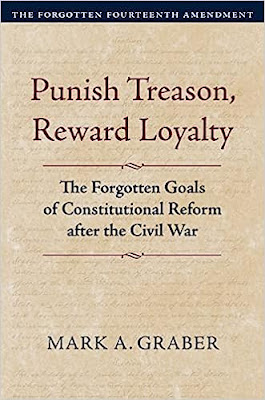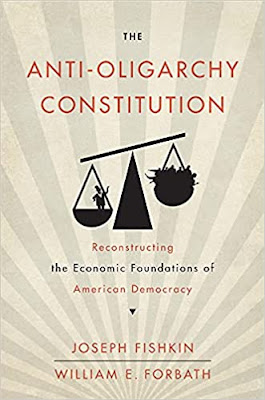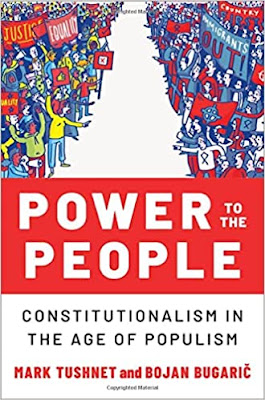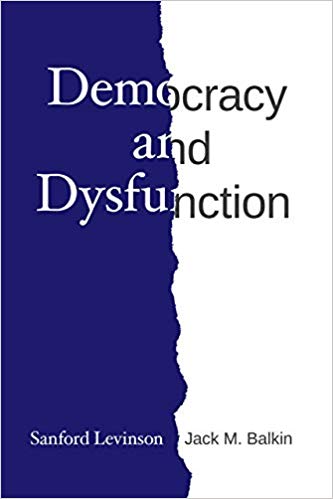Balkinization
an unanticipated consequence of
Jack M. Balkin
Balkinization Symposiums: A Continuing List
E-mail:
Jack Balkin:
jackbalkin at yahoo.com
Bruce Ackerman
bruce.ackerman at yale.edu
Ian Ayres
ian.ayres at yale.edu
Corey Brettschneider
corey_brettschneider at brown.edu
Mary Dudziak
mary.l.dudziak at emory.edu
Joey Fishkin
joey.fishkin at gmail.com
Heather Gerken heather.gerken at yale.edu
Abbe Gluck abbe.gluck at yale.edu
Mark Graber
mgraber at law.umaryland.edu
Stephen Griffin
sgriffin at tulane.edu
Jonathan Hafetz
jonathan.hafetz at shu.edu
Jeremy Kessler
jkessler at law.columbia.edu
Andrew Koppelman
akoppelman at law.northwestern.edu
Marty Lederman
msl46 at law.georgetown.edu
Sanford Levinson
slevinson at law.utexas.edu
David Luban
david.luban at gmail.com
Gerard Magliocca
gmaglioc at iupui.edu
Jason Mazzone
mazzonej at illinois.edu
Linda McClain
lmcclain at bu.edu
John Mikhail
mikhail at law.georgetown.edu
Frank Pasquale
pasquale.frank at gmail.com
Nate Persily
npersily at gmail.com
Michael Stokes Paulsen
michaelstokespaulsen at gmail.com
Deborah Pearlstein
dpearlst at yu.edu
Rick Pildes
rick.pildes at nyu.edu
David Pozen
dpozen at law.columbia.edu
Richard Primus
raprimus at umich.edu
K. Sabeel Rahmansabeel.rahman at brooklaw.edu
Alice Ristroph
alice.ristroph at shu.edu
Neil Siegel
siegel at law.duke.edu
David Super
david.super at law.georgetown.edu
Brian Tamanaha
btamanaha at wulaw.wustl.edu
Nelson Tebbe
nelson.tebbe at brooklaw.edu
Mark Tushnet
mtushnet at law.harvard.edu
Adam Winkler
winkler at ucla.edu
Compendium of posts on Hobby Lobby and related cases
The Anti-Torture Memos: Balkinization Posts on Torture, Interrogation, Detention, War Powers, and OLC
The Anti-Torture Memos (arranged by topic)
Recent Posts
Historical Empiricism and the Schleicher Trilemma
Balkinization Symposium on David Schleicher, In a Bad State: Responding to State and Local Budget Crises
Losing Big
An Old-Fashioned Filibuster
Justice Thomas and the January 6th Cases
LevinsonFest on Constitutional Crises-- Collected Posts
Republicans’ “Work Requirements” are Really Just Benefit Cut-offs for the Most Vulnerable
Just A Few Blogs
ACS Blog
Alas, a Blog
Althouse
Arts and Letters Daily
Atrios (Eschaton)
Bill of Health
Buzzflash.com
Buzz Machine
Cato at Liberty
Juan Cole (Informed Comment)
Concurring Opinions
The Constitution in 2020
Corrente
Crooked Timber
Daily Howler
Daily Kos
Dana Boyd
Brad DeLong
Digby (Hullabaloo)
Discriminations
Daniel Drezner
Kevin Drum (Mother Jones)
Electrolite
En Banc
Eunomia (Daniel Larison)
Fafblog
Michael Froomkin (Discourse.net)
GovLab (Beth Noveck)
Rick Hasen (Election Law)
History News Network
How Appealing
Ignatz (Sam Heldman)
The Importance of (Ernie Miller)
Infolaw
Instapundit
International Economic Law and Policy Blog
IntLawGrrls
Jacob Levy
Jesus' General
Jurisdynamics
The Kitchen Cabinet
Mark Kleiman
Law Blog Central
Larry Lessig
Lawyers, Guns and Money
Liberal Oasis
Brian Leiter's Law School Reports
The Leiter Reports
Marginal Revolution
Megan McArdle
Memeorandum
Metafilter
Mirror of Justice
The New Republic
Newseum
No More Mister Nice Blog
Brendan Nyhan
Opinio Juris
Orcinus
The Originalism Blog
Pandagon
Passport (Foreign Policy)
Overcoming Bias
Political Animal (Washington Monthly)
Political Theory Daily Review
Political Wire (Taegan Goddard)
The Poor Man
Virginia Postrel
Prawfsblawg
Public Reason
Jonathan Rauch
Raw Story
Redstate
ReligiousLeftLaw.com
Reporters Committee For Freedom of the Press
Reproductive Rights Blog
Rothman's Roadmap to the Right of Publicity
SCOTUS Blog
Seeing the Forest
Clay Shirky
The Shifted Librarian
The Situationist
Larry Solum (Legal Theory)
Andrew Sullivan
Talking Points Memo
Talk Left
Tapped
Tbogg
TechPresident
The Paper Chase (Jurist)
Tom Paine
Tom Tomorrow (This Modern World)
Eve Tushnet
Uggabugga
University of Chicago Law School Faculty Blog
Unqualified Offerings
The Volokh Conspiracy
War and Piece (Laura Rozen)
Wampum
Oliver Willis
Wonkette
Written Description
Matthew Yglesias
Yin
Your Choice of Feeds
1. XML
powered by
2. Atom Feed
3. RSS 2.0
Historical Empiricism and the Schleicher Trilemma
Guest Blogger
For the Balkinization symposium on David Schleicher, In a Bad State: Responding to State and Local Budget Crises (Oxford University Press, 2023). Vince Buccola The
principal object of David Schleicher’s slim, new book, In a Bad State, is
to set out a conceptual schema for mapping policy options with respect to state
and local financial distress. The Schleicher Trilemma states that no policy
response can simultaneously vindicate each of three commonsense values that
(national) political actors are apt to hold, and the book is devoted to
elaborating this core insight. There is much more to the work, of course. As anyone
who knows Schleicher even a bit will expect, the book’s 171 pages (sans notes)
brim with fascinating data and anecdotes. (Schleicher aficionados will,
however, be disappointed not to find an index entry for “Stillman, Whit.”) By
word count, much of the book (pp. 33–117) is historical. Schleicher offers a
fresh account of each major wave of state and local financial distress in the
United States, from the aftermath of the Revolutionary War through Covid-19.
The historical vignettes alone more than justify the cover price. In the
context of the book’s analytical purpose, though, they serve didactic and
argumentative functions, on one hand to illustrate the Trilemma through
real-world application and on the other to verify the causal relationships it
posits.
The Schleicher
Trilemma turns on a mismatch between policy levers and policy goals. In
Schleicher’s typology, there are three generic strategies national policy can pursue
in relation to local (in which category I’ll include state) government
financial distress. The national government can (1) bail out the local government
and its creditors; (2) encourage the local government to default on its
creditors; or (3) force the local government to pursue an austerity path—raising
taxes, cutting spending—to pay its creditors. And there are three generic
political values at stake. National policy makers will want to (A) reduce moral
hazard (for future leaders of, and lenders to, local governments); (B)
encourage future lending to local governments (to further infrastructure
investment); and (C) avoid social fallout from local collapse of services or
tax hikes. The rub is that each policy attitude sacrifices one of the values. The
choices are A(2,3), B(1,3), or C(1,2). It is
a tremendous heuristic. Like all great heuristics, it manages simultaneously to
encompass the wide universe of relevant possibility and to be, for lack of a
better word, true. One doesn’t need to indulge game-theoretic axioms or harbor
an unrealistic notion of rational expectations to see that the trade-offs Schleicher
posits are inevitable. Grasping them is fundamental for those interested in the
connection between national policy and state and local investment, and I
therefore predict that In a Bad State will long prove a starting point
in policy analysis of local financial distress in the same way that
Modigliani-Miller is still the beginning of interesting questions in corporate
finance.
Posted
9:30 AM
by Guest Blogger [link]
Balkinization Symposium on David Schleicher, In a Bad State: Responding to State and Local Budget Crises
JB
At the conclusion, David will respond to the commentators.
This week at Balkinization we are hosting a symposium on David Schleicher's new book, In a Bad State: Responding to State and Local Budget Crises (Oxford University Press, 2023).
We have assembled a terrific group of commentators, including Vincent Buccola (Penn-Wharton), Sheila Foster (Georgetown), Clay Gillette (NYU), Rick Hills (NYU), Noah Kazis (Michigan), Amy Monahan (Minnesota), Daniel Rodriguez (Northwestern), Miriam Seifter (Wisconsin), and Christopher Tyson (National Community Stabilization Trust).
Posted
9:00 AM
by JB [link]
Losing Big
David Super
President Biden
got owned. Nominally, he got owned by Speaker
Kevin McCarthy. In reality, he got owned
by Rep. Matt Gaetz. Rep. Gaetz had a clear,
well-developed long-term strategy that he followed with great discipline. The Administration had only a set of half-formed,
often contradictory, impulses that it followed haphazardly, rarely thinking
even one move ahead. It likely thinks it
won several news cycles and is hard at work trying to win another. Rep. Gaetz set out to win on substance, and
the wailing and moaning we are now hearing from the Freedom Caucus is precisely
what they ought to do to lock in their huge substantive victories and set the
stage for more. Surely the Members that
are paying attention know that they won. But by withholding their votes, they can force
even more Democrats to vote for this deal. The details have
yet to emerge, but from media accounts it appears the President agreed to a substantial
nominal-dollar cut in non-defense discretionary spending for next fiscal
year. When roughly five percent
inflation is considered, this will be a deep reduction in the capacity of the
federal government to perform its basic functions. For the following year, nominal non-defense
discretionary spending would rise one percent, which after the effects of inflation
will mean several additional percentage points of real cuts in its ability to
do its job. But it gets
worse: a lot worse. Media accounts say that veterans’ health
care, one of the larger accounts within that category, will be protected. That means that everything else will have to
absorb proportionately deeper cuts to make up for those not going to veterans’
health care. Numerous other government
functions (e.g., Border Patrol, protective details for high officials, utilities
for federal buildings) will not be cut, forcing still-bigger cuts in what remains. In addition, if
Congress and the President do not agree upon all twelve annual appropriations
bills by January 1, the agreement apparently would impose a year-long
continuing resolution (CR) with a one-percent across-the-board nominal
cut. This will give Republicans – who can
effortlessly hold back one or more bills – enormous leverage in negotiating the
content of those appropriations bills.
So not only will the levels be far below those needed to maintain
government functions, but the money that is spent will almost certainly be
badly misallocated. It remains to be
seen how these pieces fit together, but even the best-case scenario is pretty
grim. This result has
enormous long-term significance. First,
and most obviously, each year’s appropriations discussions start with the prior
year’s spending level. Merely restoring a
program to its now-current level of effectiveness will require the President and
Congress to go far above that baseline and invite the label “big spenders.” Many programs still have not recovered from
the “sequestration” cuts President Obama agreed to over a decade ago. More insidiously, underfunding
government programs will cause them to function less well. National parks will close off areas for lack
of resources for operations and maintenance.
People will miss flights as TSA lines lengthen, or those flights will
get cancelled when air traffic control is overstretched. People will get sick when contaminated meat
gets past USDA inspectors even more overwhelmed than they are today. The FDA will hold up approvals of anticipated
drugs for lack of examiners to review applications. All this will support the Republican
narrative that government is incompetent and “deserves” more funding cuts. Beyond that, the
Biden Administration passively accepted – at times even reinforced – Republicans’
profoundly tendentious framings of the issues.
Rather than working to gain public acceptance of the legal theories that
could end debt limit hostage-taking once and for all, the Administration
planted stories about how it was having trouble taking seriously “out there”
theories and the President himself pledged not to use them (and thus
obliterating his negotiating leverage). People who would
never be foolish enough to say that de-indexing the Internal Revenue Code was
not a tax increase are nonetheless accepting the inflation-denialist demand to
discuss spending programs only in nominal dollar terms. The Administration
ceded without serious contest the mantle of “fiscal conservatives” to Members
of Congress proposing huge unfunded business tax cuts that would swamp the
effects of these spending cuts. The
approach of Presidents Ronald Reagan and George W. Bush was to ram through large
unfunded tax cuts and then later “discover” a “fiscal emergency” that “required
shared sacrifice” to address. Today’s
Republicans believe they can get away with pursuing these contradictory agendas
simultaneously. And the Biden
Administration is telling them they are right. Perhaps most insidiously,
the Administration continually accepted Republicans’ characterization of
eligibility purges from basic assistance programs as “work requirements.” None of the Republicans’ main proposals for
the Temporary Assistance for Needy Families (TANF) block grant had anything to
do with putting anyone to work: they simply
sought to increase the quotas for families that states must purge from their already-shrunken
assistance programs in order to avoid creating the work programs states almost
unanimously are unwilling to operate. And the so-called
SNAP “work requirement” would cut off food assistance after just three months
to low-income people between ages 50 and 55 who cannot prove that they are
working at least half-time every month. Minimally
skilled people in this age range, which the Social Security Administration describes
as “closely approaching advanced age,” commonly see their employment prospects
dwindle as they are unable to compete with younger people at hard physical
labor. They may make ends meet with several
jobs, often with volatile
hours. If they cannot collect adequate
verification of all those hours each month, or if their total hours ever dip
below half-time, they are cut off.
Nothing in current law or the Republicans’ proposal requires states to give
individuals in need the opportunity to work for continued benefits. And despite generous financial incentives to offer
work slots, only a handful of states even purport to do so. Yet when most reporters hear about “work requirements,”
they assume that only the willfully idle are affected. And the Biden Administration has made little
effort to educate them otherwise – making its capitulation all but inevitable. President Biden had
a front-row seat for the Obama Administration’s short-sighted, strategically
clueless approach to Republican debt-limit extortion. Apparently he learned very little from
it. He had plenty of time to raise the
debt limit on a budget reconciliation bill after the election, needing no Republican
votes. All candidates for Chair of the House
Budget Committee last fall were publicly promising debt limit extortion to radically
transform the federal government. Failing to raise
the debt limit in December might have made sense as part of a plan to invoke
the 14th Amendment or to employ one of the several available
technical means of avoiding it.
Unfortunately, the Administration had no plan. This is the result. The President should tip his hat to Matt
Gaetz. @DavidASuper1
Posted
4:24 PM
by David Super [link]
An Old-Fashioned Filibuster
Gerard N. Magliocca
Long ago, a Senate filibuster involved talking marathons by a Senator or by a small group. We don't see this anymore because of modern cloture practice. But there are circumstances in which this tactic could still happen. Imagine it was the final day of a Congress and a Senator wanted to block a bill. She could take the floor and just talk until that Congress was forced to adjourn sine die. This did happen, most famously on the eve of World War I when some isolationist Senators talked a military bill to death at the end of the lame-duck session. (This filibuster spurred the creation of the first cloture rule.) Unfortunately, the debt ceiling creates a similar scenario in the middle of this Congress. Even if a budget deal is made and passes the House of Representatives, a small group of Senators could just hold a talking marathon starting on May 31 or June 1 and keep that up until they get whatever concessions they want. This is why waiting until the last minute to work out the details of vital legislation is a risky business.
Posted
9:49 AM
by Gerard N. Magliocca [link]
(0) comments
Justice Thomas and the January 6th Cases
Gerard N. Magliocca
Last year, Ginni Thomas was questioned by the January 6th Committee about her involvement with some groups that sought to challenge the presidential election result in 2020. As a result, some argue that Justice Thomas should recuse himself from any cases that flow directly from the events of January 6th, 2021. Up until now, though, this was an academic question. Not anymore. Couy Griffin, the New Mexico County Commissioner who was disqualified from office for violating Section Three of the Fourteenth Amendment on January 6th, has filed a certiorari petition. Leave aside whether the petition has merit (It doesn't). The more interesting question is whether Justice Thomas will participate in the disposition of Griffin's petition. This will tell us whether he intends to recuse from any or all such cases in the future.
Posted
12:51 PM
by Gerard N. Magliocca [link]
(0) comments
LevinsonFest on Constitutional Crises-- Collected Posts
Guest Blogger
Below are collected posts on the LevinsonFest 2022 roundtable on constitutional
crises. 1. Ashley Moran, LevinsonFest on Constitutional
Crises 2. Jack M. Balkin, Our Continuing
Constitutional Crisis 3. Kim Lane Scheppele, States of Emergency
as a Script for Undermining Constitutional Government 4. Keith E. Whittington, Bad Faith
Constitutionalism
Posted
9:30 AM
by Guest Blogger [link]
Republicans’ “Work Requirements” are Really Just Benefit Cut-offs for the Most Vulnerable
David Super
With each passing
day, it appears more likely that House Republicans will seek to provoke
the first crisis (of likely several) in the budget negotiations over what they
call “work requirements” for anti-poverty programs. This certainly has nothing to do with deficit
reduction: the amount their proposals would
save is only barely enough to pay for the deficit increases caused by their proposal
to strip the IRS of enforcement resources – and would pale compared with the cost of
their plans to extend expiring provisions of the Trump tax cuts. But these
proposals also are not about work. Instead,
the “work requirements” proposal involves taking benefits away from desperately
poor people without regard to willingness (or, often, ability) to work. That much of the news media largely gives Republicans
a free pass in rebranding an eligibility purge as a “work requirement” is a
testament to its disinterest in policy history or the well-being of the lowest-income
members of our society – as well as perhaps a longing to pretend we are still
fighting the battles of yesteryear, when our politics seemed a bit saner. Much of the criticism
the purported “work requirements” have received appropriately focuses on
Medicaid and the Supplemental Nutrition Assistance Program (SNAP, formerly food
stamps), the two largest programs Republicans are targeting. Yet the phoniness of “work requirements” is
even more apparent in the case of the Temporary Assistance for Needy Families
(TANF) block grant that replaced the Aid to Families with Dependent Children
(AFDC) program in the 1996 welfare law. With President
Clinton and Members of Congress from both parties insisting that the point of
the 1996 welfare law was moving idle recipients from welfare to work, reporters
and voters could certainly be forgiven for assuming that was so. In fact, 100% of the law’s budgetary savings
came from deep cuts in food stamps (little of which had anything to do with
work), denying subsistence benefits to immigrants legally in this country, and
terminating disability benefits to children.
The 1996 law’s
highest-profile provision – and one over which neither President Clinton nor
many congressional Democrats raised significant objections – was ending AFDC’s
individual entitlement to monthly assistance checks for very low-income
families with children and sending the money saved to states as the TANF block
grant. States did not have to spend TANF
funds on cash assistance to low-income families. Former NFL quarterback Brett Favre has been
in the headlines
lately for having received millions of TANF funds from Mississippi for giving
inspirational speeches. (His possible legal
exposure seems to come not from receiving TANF funds for that purpose but
rather from failing to bother to give those speeches.) Any money states
did spend on cash assistance to families (or its close equivalents) was subject
to a work
participation rate. For one-parent
families, at least half of the parents had to be engaged in countable work
activities for thirty hours per week.
For two-parent families, at least 90% had to have at least one parent
engaged in countable work activities at least 35 hours per week. If a state failed to meet these work
participation rate, it lost a portion of its TANF block grant and – much worse –
was subject to an embarrassing public sanction that would inevitably be understood
as allowing idleness. States concluded
that the 90% two-parent rate was utterly unmeetable because of the narrowness
of the permissible activities, the administrative difficulties of tracking
people in their first months receiving aid, and inevitable months when a parent
failed to accrue the required hours due to injury, illness, or transportation
breakdowns. States saw the 50% one-parent
rate as extremely difficult to meet for similar reasons and because of the
staggering cost of the child care required.
The law, however,
offered states an out. Their required
work participation rates would drop one percentage point for every percentage
point their caseloads declined. Thus, a
state terminating assistance to half the families that had previously received
it would have no work participation rate at all for the remaining one-parent
families and would have a more manageable 40% rate for two-parent families. It actually became more advantageous for
states simply to cut off aid to a family than to get the family into work
activities. Across the
political spectrum, states concluded it was too expensive and administratively
burdensome to run the kinds of large work programs that most people assumed the
1996 law would create. (A rare exception was New York Mayor Rudy Giuliani, who
made welfare recipients pick up trash from city parks without gloves while
sharply reducing Parks Department employment.)
Instead, states focused on the caseload reduction credit, purged
families en masse from their cash assistance programs, and met their
work participation rates despite having very few recipients engaged in
countable work activities for the required number of hours. Many states had zero work participation rates
for one-parent families. Those that had
some residual work participation rate often filled it not by giving work
opportunities to recipients but by making token cash payments to non-recipients
who were already working the required number of hours. After initially
cheering the precipitous decline in families getting aid, Republicans began
attacking states for having so few people counted as working. Even though the caseload reduction credit was
their idea in a law they had written and passed, Republicans decried it as a
loophole and again demanded tougher “work requirements.” Predictably, these demands for “work
requirements” ended the same way similar demands had a decade earlier. A Republican
Congress amended the TANF statute in 2006 to deny states any credit for
caseload reductions up to that point in calculating their work participation
rates. It also prohibited
some methods states had used to get aid to desperate families outside of the
work participation rate structure. States again had a
choice between operating rigorous, tightly constrained work programs for cash
assistance recipients or re-purging their already-shrunken rolls. And again, across the political spectrum,
states opted to pursue new caseload reduction credits and removed more desperately
needy families from cash assistance. When the Great
Recession sharply increased the number of families needing aid, this strategy
precluded states from meeting that need.
Indeed, states felt they could least afford to start substantial work
programs with their budgets buckling as tax revenues declined. President Obama’s 2009 stimulus package temporarily
suspended the work participation rates and gave states extra funds to operate
public job creation programs. By this
time, however, many states were fully committed to their caseload reduction strategies
and unwilling or unable to turn back. Thus,
despite huge increases in need, about half the states saw their cash assistance
caseloads stagnate or decline. When the work
participation rate suspension and job creation funding expired in a still-weak
economy, the rest of the states turned again to the caseload reduction
credit. Very few of the genuine work
programs the stimulus law had funded survived its expiration. Having played the “tougher
work requirements” card twice with very little pushback, House Republicans unsurprisingly
are eager to go for the hat trick. Their
debt limit bill would
again force states to purge their cash assistance programs – which at this
point serve few but the most desperate families – to claim caseload reduction
credits. It also would eliminate the
modest flexibility states have under the current law to provide cash aid to
people who cannot work due to illness, injury, homelessness, the need to hide
from an abusive partner, lack of transportation, or residence in an isolated
rural area without accessible jobs. Prior purges have
made cash assistance unavailable
to vast numbers of extremely poor families with no alternative. The number of families receiving cash
assistance in 1996 was about two-thirds the number of families in poverty that
year. By 2020, the number of families
receiving cash assistance was just 21% of the
number of families in poverty. Most of
those that remain face severe obstacles to work. States that declined to operate work programs for the far more
work-capable recipients of the 1990s or 2000s are certainly not going to do so
for the extremely difficult- and expensive-to-serve families that now get cash
assistance. Some states might
well determine that providing cash assistance to parents with children is no longer
viable. This likely would result
in significant numbers of children being removed from their parents and placed
into foster care (where a federal entitlement to cash assistance remains). This deeply anti-family policy is stunningly
hypocritical for the party that claims to be the champion of traditional families. More importantly, it would spell tragedy for countless
parents and children while swamping states’ already overburdened foster care
systems. President Biden’s
initial response to House Republicans’ demand for “work requirements” was that
he voted for the 1996 welfare law, and its strong work requirements remain on
the books. He should not fall for the “work
requirements” trick a third time. @DavidASuper1
Posted
12:45 AM
by David Super [link]
Books by Balkinization Bloggers

Linda C. McClain and Aziza Ahmed, The Routledge Companion to Gender and COVID-19 (Routledge, 2024)

David Pozen, The Constitution of the War on Drugs (Oxford University Press, 2024)

Jack M. Balkin, Memory and Authority: The Uses of History in Constitutional Interpretation (Yale University Press, 2024)

Mark A. Graber, Punish Treason, Reward Loyalty: The Forgotten Goals of Constitutional Reform after the Civil War (University of Kansas Press, 2023)

Jack M. Balkin, What Roe v. Wade Should Have Said: The Nation's Top Legal Experts Rewrite America's Most Controversial Decision - Revised Edition (NYU Press, 2023)

Andrew Koppelman, Burning Down the House: How Libertarian Philosophy Was Corrupted by Delusion and Greed (St. Martin’s Press, 2022)

Gerard N. Magliocca, Washington's Heir: The Life of Justice Bushrod Washington (Oxford University Press, 2022)

Joseph Fishkin and William E. Forbath, The Anti-Oligarchy Constitution: Reconstructing the Economic Foundations of American Democracy (Harvard University Press, 2022)

Mark Tushnet and Bojan Bugaric, Power to the People: Constitutionalism in the Age of Populism (Oxford University Press 2021).

Mark Philip Bradley and Mary L. Dudziak, eds., Making the Forever War: Marilyn B. Young on the Culture and Politics of American Militarism Culture and Politics in the Cold War and Beyond (University of Massachusetts Press, 2021).

Jack M. Balkin, What Obergefell v. Hodges Should Have Said: The Nation's Top Legal Experts Rewrite America's Same-Sex Marriage Decision (Yale University Press, 2020)

Frank Pasquale, New Laws of Robotics: Defending Human Expertise in the Age of AI (Belknap Press, 2020)

Jack M. Balkin, The Cycles of Constitutional Time (Oxford University Press, 2020)

Mark Tushnet, Taking Back the Constitution: Activist Judges and the Next Age of American Law (Yale University Press 2020).

Andrew Koppelman, Gay Rights vs. Religious Liberty?: The Unnecessary Conflict (Oxford University Press, 2020)

Ezekiel J Emanuel and Abbe R. Gluck, The Trillion Dollar Revolution: How the Affordable Care Act Transformed Politics, Law, and Health Care in America (PublicAffairs, 2020)

Linda C. McClain, Who's the Bigot?: Learning from Conflicts over Marriage and Civil Rights Law (Oxford University Press, 2020)

Sanford Levinson and Jack M. Balkin, Democracy and Dysfunction (University of Chicago Press, 2019)

Sanford Levinson, Written in Stone: Public Monuments in Changing Societies (Duke University Press 2018)

Mark A. Graber, Sanford Levinson, and Mark Tushnet, eds., Constitutional Democracy in Crisis? (Oxford University Press 2018)

Gerard Magliocca, The Heart of the Constitution: How the Bill of Rights became the Bill of Rights (Oxford University Press, 2018)

Cynthia Levinson and Sanford Levinson, Fault Lines in the Constitution: The Framers, Their Fights, and the Flaws that Affect Us Today (Peachtree Publishers, 2017)

Brian Z. Tamanaha, A Realistic Theory of Law (Cambridge University Press 2017)

Sanford Levinson, Nullification and Secession in Modern Constitutional Thought (University Press of Kansas 2016)

Sanford Levinson, An Argument Open to All: Reading The Federalist in the 21st Century (Yale University Press 2015)

Stephen M. Griffin, Broken Trust: Dysfunctional Government and Constitutional Reform (University Press of Kansas, 2015)

Frank Pasquale, The Black Box Society: The Secret Algorithms That Control Money and Information (Harvard University Press, 2015)

Bruce Ackerman, We the People, Volume 3: The Civil Rights Revolution (Harvard University Press, 2014)
Balkinization Symposium on We the People, Volume 3: The Civil Rights Revolution

Joseph Fishkin, Bottlenecks: A New Theory of Equal Opportunity (Oxford University Press, 2014)

Mark A. Graber, A New Introduction to American Constitutionalism (Oxford University Press, 2013)

John Mikhail, Elements of Moral Cognition: Rawls' Linguistic Analogy and the Cognitive Science of Moral and Legal Judgment (Cambridge University Press, 2013)

Gerard N. Magliocca, American Founding Son: John Bingham and the Invention of the Fourteenth Amendment (New York University Press, 2013)

Stephen M. Griffin, Long Wars and the Constitution (Harvard University Press, 2013)

Andrew Koppelman, The Tough Luck Constitution and the Assault on Health Care Reform (Oxford University Press, 2013)

James E. Fleming and Linda C. McClain, Ordered Liberty: Rights, Responsibilities, and Virtues (Harvard University Press, 2013)
Balkinization Symposium on Ordered Liberty: Rights, Responsibilities, and Virtues

Andrew Koppelman, Defending American Religious Neutrality (Harvard University Press, 2013)

Brian Z. Tamanaha, Failing Law Schools (University of Chicago Press, 2012)

Sanford Levinson, Framed: America's 51 Constitutions and the Crisis of Governance (Oxford University Press, 2012)

Linda C. McClain and Joanna L. Grossman, Gender Equality: Dimensions of Women's Equal Citizenship (Cambridge University Press, 2012)

Mary Dudziak, War Time: An Idea, Its History, Its Consequences (Oxford University Press, 2012)

Jack M. Balkin, Living Originalism (Harvard University Press, 2011)

Jason Mazzone, Copyfraud and Other Abuses of Intellectual Property Law (Stanford University Press, 2011)

Richard W. Garnett and Andrew Koppelman, First Amendment Stories, (Foundation Press 2011)

Jack M. Balkin, Constitutional Redemption: Political Faith in an Unjust World (Harvard University Press, 2011)

Gerard Magliocca, The Tragedy of William Jennings Bryan: Constitutional Law and the Politics of Backlash (Yale University Press, 2011)

Bernard Harcourt, The Illusion of Free Markets: Punishment and the Myth of Natural Order (Harvard University Press, 2010)

Bruce Ackerman, The Decline and Fall of the American Republic (Harvard University Press, 2010)
Balkinization Symposium on The Decline and Fall of the American Republic

Ian Ayres. Carrots and Sticks: Unlock the Power of Incentives to Get Things Done (Bantam Books, 2010)

Mark Tushnet, Why the Constitution Matters (Yale University Press 2010)
Ian Ayres and Barry Nalebuff: Lifecycle Investing: A New, Safe, and Audacious Way to Improve the Performance of Your Retirement Portfolio (Basic Books, 2010)
.jpg)
Jack M. Balkin, The Laws of Change: I Ching and the Philosophy of Life (2d Edition, Sybil Creek Press 2009)

Brian Z. Tamanaha, Beyond the Formalist-Realist Divide: The Role of Politics in Judging (Princeton University Press 2009)

Andrew Koppelman and Tobias Barrington Wolff, A Right to Discriminate?: How the Case of Boy Scouts of America v. James Dale Warped the Law of Free Association (Yale University Press 2009)

Jack M. Balkin and Reva B. Siegel, The Constitution in 2020 (Oxford University Press 2009)
Heather K. Gerken, The Democracy Index: Why Our Election System Is Failing and How to Fix It (Princeton University Press 2009)

Mary Dudziak, Exporting American Dreams: Thurgood Marshall's African Journey (Oxford University Press 2008)

David Luban, Legal Ethics and Human Dignity (Cambridge Univ. Press 2007)

Ian Ayres, Super Crunchers: Why Thinking-By-Numbers is the New Way to be Smart (Bantam 2007)

Jack M. Balkin, James Grimmelmann, Eddan Katz, Nimrod Kozlovski, Shlomit Wagman and Tal Zarsky, eds., Cybercrime: Digital Cops in a Networked Environment (N.Y.U. Press 2007)

Jack M. Balkin and Beth Simone Noveck, The State of Play: Law, Games, and Virtual Worlds (N.Y.U. Press 2006)

Andrew Koppelman, Same Sex, Different States: When Same-Sex Marriages Cross State Lines (Yale University Press 2006)
Brian Tamanaha, Law as a Means to an End (Cambridge University Press 2006)
Sanford Levinson, Our Undemocratic Constitution (Oxford University Press 2006)
Mark Graber, Dred Scott and the Problem of Constitutional Evil (Cambridge University Press 2006)
Jack M. Balkin, ed., What Roe v. Wade Should Have Said (N.Y.U. Press 2005)
Sanford Levinson, ed., Torture: A Collection (Oxford University Press 2004)
Balkin.com homepage
Bibliography
Conlaw.net
Cultural Software
Writings
Opeds
The Information Society Project
BrownvBoard.com
Useful Links
Syllabi and Exams
